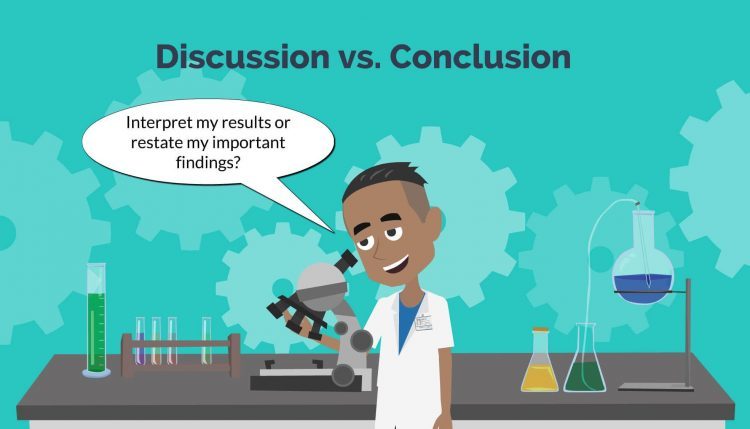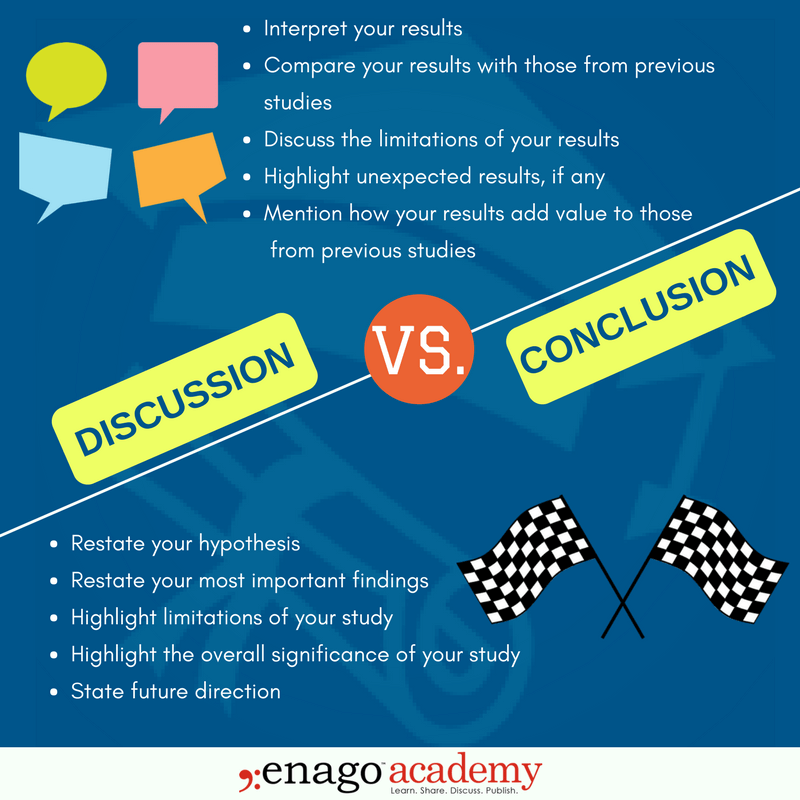What Should Be in a Discussion and a Conclusion for a Literature Review

The discussion section of your manuscript can be ane of the hardest to write every bit information technology requires yous to call back nigh the meaning of the research you lot have done. An effective discussion section tells the reader what your study means and why it is of import. In this article, we will comprehend some pointers for writing clear/well-organized give-and-take and conclusion sections and discuss what should Not exist a function of these sections.
What Should be in the Give-and-take Section?
Your word is, in short, the answer to the question "what do my results hateful?" The give-and-take section of the manuscript should come after the methods and results section and before the conclusion. It should relate dorsum directly to the questions posed in your introduction, and contextualize your results within the literature you have covered in your literature review. In social club to make your discussion section engaging, yous should include the following information:
- The major findings of your study
- The meaning of those findings
- How these findings relate to what others accept done
- Limitations of your findings
- An explanation for whatever surprising, unexpected, or inconclusive results
- Suggestions for further research
Your discussion should NOT include any of the following information:
- New results or data non presented previously in the paper
- Unwarranted speculation
- Tangential issues
- Conclusions not supported past your data
Related: Avoid outright rejection with a well-structured manuscript. Check out these resource and better your manuscript now!
How to Make the Discussion Section Constructive?
At that place are several ways to brand the word section of your manuscript effective, interesting, and relevant.
- Most writing guides recommend listing the findings of your study in decreasing order of their importance. You lot would not want your reader to lose sight of the key results that you found. Therefore, put the most of import finding front and center.
Instance: Imagine that you acquit a study aimed at evaluating the effectiveness of stent placement in patients with partially blocked arteries. Y'all find that despite this existence a common commencement-line treatment, stents are not effective for patients with partially blocked arteries. The report as well discovers that patients treated with a stent tend to develop asthma at slightly higher rates than those who receive no such treatment.
Which sentence would yous choose to begin your word?
Our findings suggest that patients who had partially blocked arteries and were treated with a stent as the offset line of intervention had no better outcomes than patients who were not given any surgical treatments.
Our findings noted that patients who received stents demonstrated slightly higher rates of asthma than those who did not. In add-on, the placement of a stent did non impact their rates of cardiac events in a statistically significant way.
If you chose the kickoff example, you are correct!
- If you are non sure which results are the most of import, get back to your research question and start from at that place. The most important result is the ane that answers your research question.
- Information technology is also necessary to contextualize the meaning of your findings for the reader. What does previous literature say, and do your results agree? Practise your results elaborate on previous findings, or differ significantly?
- In our stent example, if previous literature constitute that stents were an effective line of treatment for patients with partially blocked arteries, yous should explore why your interpretation seems different in the discussion section. Did your methodology differ? Was your written report broader in scope and larger in calibration than the previous studies? Were at that place any limitations to previous studies that your written report overcame? Alternatively, is it possible that your ain report could be wrong considering of some difficulties you had in carrying it out? The discussion section should narrate a coherent story to the target audience.
- Finally, remember not to innovate new ideas/data, or speculate wildly on the possible future implications of your study in the word section. Yet, considering alternative explanations for your results is encouraged.

Avoiding Defoliation in your Conclusion!
Many writers confuse the information they should include in their give-and-take with the information they should identify in their conclusion. One easy way to avoid this confusion is to recall of your conclusion as a summary of everything that you have said thus far. In the determination section, you remind the reader of what they have merely read. Your decision should:
- Restate your hypothesis or research question
- Restate your major findings
- Tell the reader what contribution your study has made to the existing literature
- Highlight any limitations of your study
- Land future directions for enquiry/recommendations
Your conclusion should NOT:
- Innovate new arguments
- Introduce new information
- Fail to include your research question
- Fail to state your major results
An advisable decision to our hypothetical stent study might read as follows:
In this study, we examined the effectiveness of stent placement. Nosotros compared the patients with partially blocked arteries to those with not-surgical interventions. After examining the five-year medical outcomes of 19,457 patients in the Greater Dallas area, our statistical analysis concluded that the placement of a stent resulted in outcomes that were no ameliorate than non-surgical interventions such as diet and exercise. Although previous findings indicated that stent placement improved patient outcomes, our study followed a greater number of patients than those in major studies conducted previously. It is possible that outcomes would vary if measured over a ten or fifteen year menses. Future researchers should consider investigating the touch of stent placement in these patients over a longer menses (five years or longer). Regardless, our results point to the need for medical practitioners to reconsider the placement of a stent every bit the start line of handling as not-surgical interventions may have equally positive outcomes for patients.
Did you discover the tips in this article relevant? What is the almost challenging portion of a inquiry newspaper for you to write? Allow united states of america know in the comments section below!

Sign-upward to read more
Subscribe for free to get unrestricted admission to all our resource on research writing and academic publishing including:
- 2000+ blog articles
- l+ Webinars
- 10+ Proficient podcasts
- 50+ Infographics
- Q&A Forum
- ten+ eBooks
- 10+ Checklists
- Research Guides
Please enter a valid personal electronic mail
Nosotros hate spam too. We promise to protect your privacy and never spam yous.
Source: https://www.enago.com/academy/discussion-conclusion-know-difference-drafting-manuscript/#:~:text=Restate%20your%20major%20findings,future%20directions%20for%20research%2Frecommendations

0 Response to "What Should Be in a Discussion and a Conclusion for a Literature Review"
Post a Comment